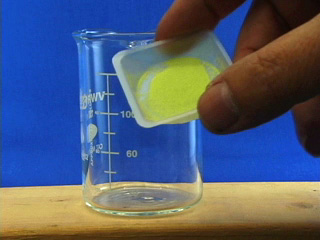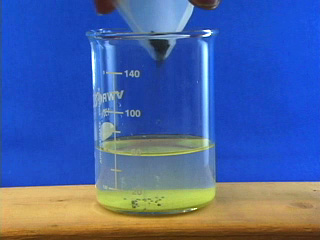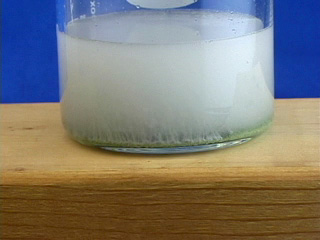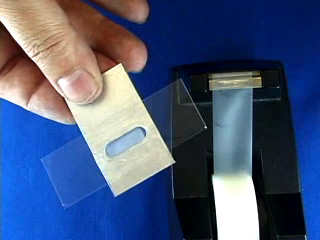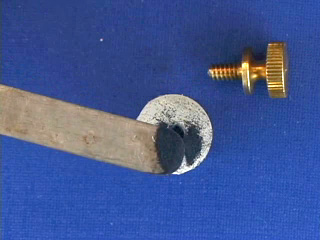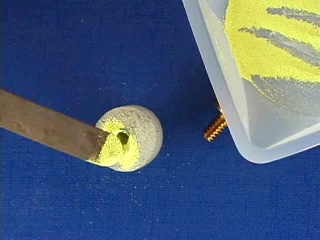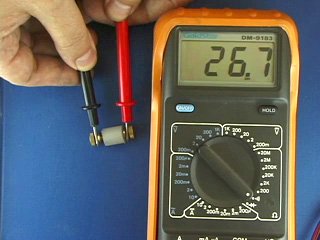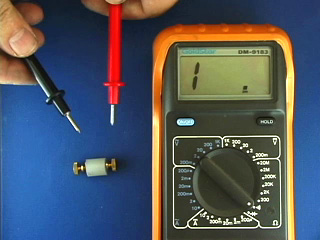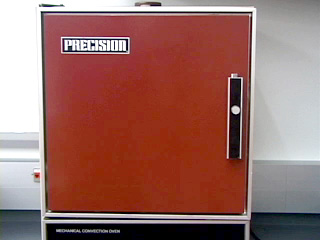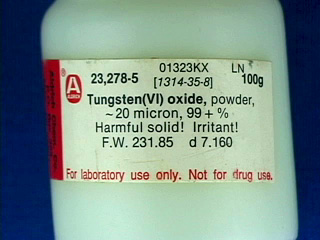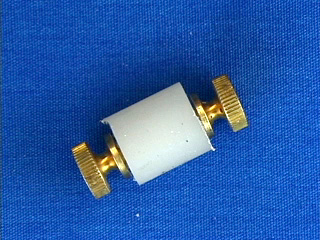
Tungsten Trioxide Intercalation
This procedure was modified by Tess Jacquez and George Lisensky from "Hydrogen Insertion into WO3" by M. Stanley Whittingham in Teaching General Chemistry: A Materials Science Companion, ACS Books (1993).
Tungsten trioxide has an idealized rhenium oxide, ReO3, structure consisting of WO6 octahedra joined at their corners. It may also be considered as having the perovskite structure of CaTiO3 with all of the calcium sites vacant. An atom inserted into the center of the WO3 structure gives MxWO3, where M can be an H, Li, Na, K, Rb, Ca, Sr, Ba, Al, In, Tl, Sn, Pb, Cu, Ag, Cd, the rare earth elements, or NH4+. In this experiment, you are going to make HxWO3.
xH+ + xe- + WO3 → HxW1-xO3
Partial reduction of the WO3 and charge balance through intercalation of hydrogen ions into the cavities of the structure adds electrons to the conduction band
resulting in color and conductivity changes. These electrons make the material behave like a metal, with both its conductivity and color being derived from free electron behavior.
Redox coloration reactions are now being used in electrochromic displays for sunglasses and rear-view mirrors in cars,
and has been proposed for adjusting the transmission of light through the glass panes in large buildings.
| Procedure | Wear eye protection |
Place 0.5 g of WO3 into a 150-mL beaker. CAUTION: WO3 is an irritant. Avoid creating or breathing dust. Avoid eye and skin contact. Wash hands thoroughly after handling.
Add about 50 mL of 3 M hydrochloric acid onto the WO3. What happens? Add 0.6 g zinc filings to the acid and observe what takes place. CAUTION: Keep away from open flames. Wait for the reaction to finish.
(During this time record the conductivity and the x-ray powder diffraction of the starting material. See below.) After all reaction has ceased, suction-filter off the solid product. Wash twice with water and air-dry for a few minutes. Record the weight of dry product obtained.
X-Ray Powder Diffraction
Tightly wrap a piece of tape with the sticky side out all the way around a microscope slide. Stick to an aluminum holder. Fill the holder with powder and smooth to a uniform depth. Prepare both the product and the starting material. For both the product and for the starting material place the holder in the diffractometer and scan from 20 to 35°. Have you obtained a different material? WO3 is triclinic with three strong peaks having d spacing greater than 3.6 Å, each corresponding to half a unit cell dimension. HxWO3 has higher (tetragonal) symmetry.Electrical Resistance
Use a plastic nut and two bolts. Screw a bolt all the way into one side. Add sample. Screw another bolt into the opposite side. Tighten the thumbscrew by hand. Is the pressed powder conductive? Compare resistance of the starting material with that of the product.Reversibility
Place the sample in an oven at 100°C for 90 minutes or keep the sample at room temperature for three days. Change in coloration can show alteration on the molecular level, but conductivity and x-ray diffraction analysis can verify if the reaction is indeed reversible.
- What is the color of the WO3? of HxWO3?
- Are there any visible changes when hydrochloric acid is added to the WO3 in beaker?
- Which is a better reducing agent, H2 or Zn(s)?
- What weight of starting material did you use? What weight of product did you get?
- Have you synthesized a different material? How do you know?
- Are the pressed powders conductive? Is there a conductivity difference between starting material and product?
- Is the reaction reversible? What data supports your answer?
- What are the balanced chemical equations for the reduction and re-oxidation in air of the WO3?
Developed in collaboration with the
University of Wisconsin Materials Research Science and Engineering Center
Interdisciplinary Education Group | MRSEC on Nanostructured Interfaces
This page created by George Lisensky, Beloit College. Last modified November 12, 2013 .
University of Wisconsin Materials Research Science and Engineering Center
Interdisciplinary Education Group | MRSEC on Nanostructured Interfaces
This page created by George Lisensky, Beloit College. Last modified November 12, 2013 .
